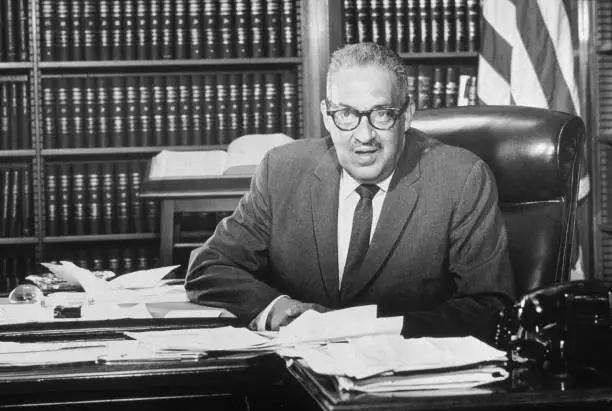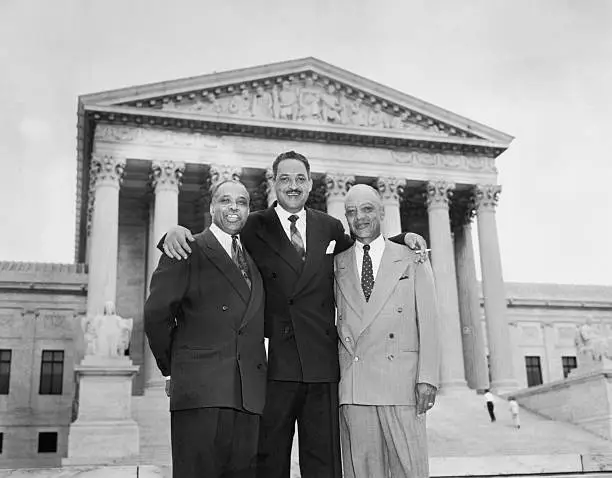Thurgood Marshall and the Civil Rights Revolution
Thurgood Marshall stands as a towering figure in the history of American law, remembered for his relentless fight for civil rights and his groundbreaking legal victories that transformed the landscape of racial equality in the United States. As the lead attorney for the NAACP and later the first African American to serve on the U.S. Supreme Court, Marshall’s contributions to the civil rights revolution reshaped not only American legal doctrine but also the nation’s moral fabric.
His efforts culminated in landmark victories such as Brown v. Board of Education, which ended legal segregation in public schools. This article explores Marshall’s pivotal role in the civil rights revolution, from his early legal battles to his lasting legacy as a champion of justice.
Table of Contents
Early Life and Legal Education
Born in Baltimore, Maryland, in 1908, Thurgood Marshall grew up in a segregated society that routinely denied African Americans access to basic rights and opportunities. His parents, particularly his father, instilled in him a deep respect for the U.S. Constitution and the law, often engaging him in debates that sharpened his skills in critical thinking and argumentation.
Marshall attended Lincoln University, a historically Black college, and later applied to the University of Maryland School of Law. However, because of segregation, Marshall was denied admission. This personal encounter with racial discrimination profoundly affected him and fueled his desire to use the law as a tool for dismantling segregation. Marshall instead enrolled at Howard University School of Law, where he studied under the guidance of Charles Hamilton Houston, a visionary legal strategist known as “The Man Who Killed Jim Crow.” Houston’s mentorship shaped Marshall’s legal philosophy, emphasizing the use of the courts to challenge and dismantle institutionalized racism.

Marshall’s Role in the NAACP Legal Defense Fund
In 1936, Thurgood Marshall joined the NAACP (National Association for the Advancement of Colored People) as a staff attorney, beginning a long and distinguished career as one of the most influential civil rights lawyers in history. At the NAACP, Marshall worked alongside Houston to develop a legal strategy aimed at overturning the “separate but equal” doctrine established in the 1896 Supreme Court case Plessy v. Ferguson, which had legalized segregation.
Marshall and Houston realized that incremental legal victories were the key to dismantling segregation. They began by attacking segregation in education, where they argued that segregated schools were inherently unequal, denying African American students the same quality of education as their white counterparts. Over the next decade, Marshall led a series of cases that challenged the constitutionality of segregation in higher education, laying the groundwork for the historic Brown v. Board of Education decision.
Brown v. Board of Education: A Landmark Victory
In 1954, Thurgood Marshall achieved his most significant legal victory with Brown v. Board of Education of Topeka, a case that challenged racial segregation in public schools. Marshall served as the lead attorney for the plaintiffs, representing African American families who argued that segregation violated the Equal Protection Clause of the Fourteenth Amendment.
Marshall’s argument was based on the idea that segregation inflicted psychological harm on African American children, fostering a sense of inferiority that damaged their educational and emotional development. His case was bolstered by the testimony of expert psychologists and social scientists, who provided evidence that segregation created profound and lasting negative effects on children’s mental health and ability to learn.
In a unanimous decision, the Supreme Court, under Chief Justice Earl Warren, ruled in favor of the plaintiffs, declaring that “separate educational facilities are inherently unequal.” The decision in Brown overturned the Plessy v. Ferguson precedent and marked the beginning of the end for legalized segregation in the United States. Marshall’s victory in Brown is widely considered one of the most important legal rulings in American history, not only because it dismantled segregation in schools but because it set the stage for broader civil rights advancements in subsequent decades.

Post-Brown Legal Battles and Civil Rights Advocacy
While Brown v. Board of Education was a monumental victory, the fight to desegregate schools and implement the ruling was far from over. Marshall continued to fight legal battles throughout the 1950s and 1960s to ensure that desegregation orders were enforced, often facing fierce opposition from Southern states and resistance from local governments.
In addition to his work on school desegregation, Marshall played a crucial role in other areas of civil rights law, challenging racial discrimination in housing, voting rights, and employment. Cases like Shelley v. Kraemer (1948), which challenged racial covenants in real estate, and Smith v. Allwright (1944), which struck down the exclusion of Black voters from Democratic primaries in Texas, showcased Marshall’s broad impact on civil rights litigation.
Marshall’s legal victories helped pave the way for the civil rights movement of the 1960s, influencing legislative changes such as the Civil Rights Act of 1964 and the Voting Rights Act of 1965. His work in the courts complemented the activism of civil rights leaders like Martin Luther King Jr., making him a crucial figure in the broader struggle for racial equality.
Thurgood Marshall as Supreme Court Justice
In 1967, Thurgood Marshall made history once again when President Lyndon B. Johnson nominated him to the U.S. Supreme Court, making him the first African American to serve on the nation’s highest court. Marshall’s confirmation marked a significant milestone in the civil rights movement, symbolizing the progress that had been made in the fight for racial justice.
As a Supreme Court Justice, Marshall remained a staunch advocate for individual rights and civil liberties, often writing powerful dissents in cases where the court’s majority upheld policies that he believed undermined equality and justice. He was a consistent voice for the protection of marginalized communities, opposing the death penalty, advocating for gender equality, and defending the rights of the poor and disenfranchised.
During his 24-year tenure on the Supreme Court, Marshall’s opinions reflected his lifelong commitment to using the law as a tool for social change. Though he sometimes found himself in the minority on the increasingly conservative court, his dissents laid the intellectual groundwork for future civil rights advancements.
Marshall’s Legacy and the Ongoing Civil Rights Revolution
Thurgood Marshall’s legacy extends far beyond his victories in the courtroom. He remains an enduring symbol of the power of the law to challenge injustice and effect social change. His work helped transform the legal landscape of the United States, moving the nation closer to its ideals of equality and fairness for all citizens.
Marshall’s legal strategies and victories in cases like Brown v. Board of Education continue to influence civil rights litigation to this day. His work provided a blueprint for using the courts to address systemic inequality, inspiring future generations of lawyers to fight for justice in areas such as voting rights, criminal justice reform, and LGBTQ+ rights.
Moreover, Marshall’s elevation to the Supreme Court represented a significant breakthrough in American society, demonstrating that African Americans could achieve the highest levels of power and influence in government and law. His life’s work is a testament to the enduring importance of the legal profession in advancing civil rights and ensuring that the promises of the Constitution apply to all citizens, regardless of race.
Conclusion
Thurgood Marshall’s role in the civil rights revolution cannot be overstated. As a lawyer, he dismantled the legal foundations of segregation and helped usher in a new era of racial equality in the United States. As a Supreme Court Justice, he continued to fight for justice and equality, leaving behind a legacy of moral courage and legal brilliance. Today, his life and work serve as a reminder of the transformative power of law in the pursuit of a more just society.
Related Articles For You:
Portraits of Famous Trial Lawyers: A Visual History of Legal Titans
Erle Stanley Gardner and Other Legendary Trial Lawyers Who Shaped Legal History
Top 10 Trial Lawyers Who Changed Legal History
FAQs
What was Thurgood Marshall’s most famous legal victory?
Thurgood Marshall’s most famous legal victory was Brown v. Board of Education in 1954, where the U.S. Supreme Court ruled that racial segregation in public schools was unconstitutional. This decision marked the beginning of the end for legalized segregation in the United States.
How did Thurgood Marshall influence the civil rights movement?
Thurgood Marshall played a crucial role in the civil rights movement by using legal strategies to challenge segregation and discrimination in education, voting, housing, and employment. His work in the courts complemented the activism of civil rights leaders and helped secure landmark legal victories that advanced racial equality
What is Thurgood Marshall’s legacy as a Supreme Court Justice?
As the first African American Supreme Court Justice, Thurgood Marshall’s legacy is marked by his unwavering commitment to civil rights, individual liberties, and social justice. He was a consistent advocate for marginalized communities, and his opinions continue to influence civil rights litigation today.
About the Author

Sarah Klein, JD, is a licensed attorney and legal content strategist with over 12 years of experience across civil, criminal, family, and regulatory law. At All About Lawyer, she covers a wide range of legal topics — from high-profile lawsuits and courtroom stories to state traffic laws and everyday legal questions — all with a focus on accuracy, clarity, and public understanding.
Her writing blends real legal insight with plain-English explanations, helping readers stay informed and legally aware.
Read more about Sarah
